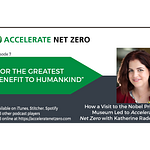In this episode, Will Harrison of Synapse Product Development shares his thoughts around how to build sustainability into all types of products from the beginning stages of development. To achieve Ne…
Listen to this episode with a 7-day free trial
Subscribe to Accelerate Net Zero to listen to this post and get 7 days of free access to the full post archives.











